Kitchen Project #141: Sarah Johnson's Cherry Schiacciata
It's a cookbook special ft. FRUITFUL!
Hello,
Welcome to today’s edition of Kitchen Projects. It’s so wonderful to have you here.
Today, it’s one of my FAVOURITE kinds of newsletters: It’s a cookbook special! I have the pleasure of delving in to the gorgeous world of Fruitful by Sarah Johnson. I sat down with Sarah to more about the journey she took to write her book, and am thrilled to be sharing one of her favourite recipes a Cherry Schiacciata, a delightful bread and way to enjoy the best of the summer season.
Over on KP+, I’m sharing a recipe from Sarah - Frozen Yoghurt-Honey Parfait with Flash Roasted Blueberries. How gorgeous! Click here to read it. I’m also giving away a copy of Sarah’s book to a subscriber - check the post for more details.
What's KP+? Well, it's the level-up version of this newsletter. By joining KP+, you will support the writing and research that goes into the newsletter (including the commissioning - and fair payment - of all the writers), join a growing community, access extra content (inc., the entire archive with 300+ recipes) and more. Subscribing is easy and only costs £6 per month or just £50 per year (equivalent to £4.10 per month). Why not give it a go? Come and join the gang!
Love,
Nicola
Fruitful by Name… Fruitful by Nature
There are some books that just immediately feel like they've been around forever. The sort of book that you can imagine seeing in the small collection of books kept on the window sill of a perfectly formed, unassuming restaurant that just served you the best crab on toast of your life. Authoritative but, crucially, a friend. A book that guides rather than directs. Suggests, never forces. Fruitful, the debut by Sarah Johnson, is just one of those books.
Published earlier this year by Kyle, 'Fruitful: Sweet and Savoury Fruit Recipes Inspired by Farms, Orchards and Gardens' is a book that shows us, ever so gently, the multitude of ways to celebrate fruit. The first time I flicked through the book, the word that immediately sprang to mind was 'peaceful'. Its pages are so calming, filled with recipes that let your mind drift into a myriad of relaxing sun-speckled afternoons and cosy dinners.
From flash-roasted blueberries to warm almond-stuffed apricots with fior di latte to rhubarb buckwheat almond muffins and mulberry sorbet, Fruitful spins a world of eating and sharing that I want to live in forever! And there's plenty of savoury, like the mackerel with gooseberry compote and roast chicken with quince aioli. You feel immediately that you are in good hands. The recipes are comforting but clean, respectful but adventurous, modern yet classic, always getting to the essence of the ingredients.
The good hands in question belong to Sarah Johnson, the brilliant pastry chef and head of Pastry Development for Spring and Heckfield Place. Having trained at Chez Panisse in California (she was also born in Southern California) and running the pastry development at the ever-gorgeous Spring, I'm confident that anything Sarah doesn't know about fruit simply isn't worth knowing!
In my sprawling but underutilised personal cookbook library, the fruit books are easily my most referenced. The reason is I lack self-control. When I walk around a farmers' market or my local greengrocers, I have no off switch for buying fruit; working in professional kitchens warped my perspective. For years, I was so used to fruit arriving in towering piles that I don't know when to stop when filling up a paper bag. It's not until I get home and see the huge glut in front of me, my own personal farmer's market stall, that I realise this fruit needs processing. So, I turn to my favourite fruit-focused books to get inspired, and I'm so thrilled that Fruitful is the squad's newest member.
From in-depth descriptions and classifications to inspirational pairings and cooking methods, along with best-practice preparation techniques, I know that Fruitful will help me navigate the gorgeously unpredictable behaviour of the season's best (and help patch over my problematic lack of willpower). Recipes aside, Sarah has written excellent and incredibly useful flavour pairing charts for every fruit, too - charmingly, it is also peppered with first-person essays from fruit growers across the world.
I sat down with Sarah to learn more about her journey into becoming a pastry chef, writing fruitful, and who wins the European vs. Californian produce-off (spoiler alert: both sides are victorious).
A journey from California to London
Fittingly, Sarah Johnson says that she fell in love with fruit and farming "via osmosis."
A Los Angeles native, she made her way to Northern California for university and found herself surrounded by lush valleys and farmland. Enrolling at UC Davis, located in the "beating heart of California's agricultural economy," to study International Environmental Policy, she was surrounded by farms. After university, she followed the breadcrumb trail left by the local farmers markets and the smaller organic farms that she had grown to love and ended up at the epicentre of North Californian farm-to-table cooking: Chez Panisse.
Here, osmosis was at play again. Starting in Front of House (just like fellow Chez Panisse alumni Samin Nosrat!), it was a few years into the job before she stepped into the kitchen. "I thought it would just be absolutely ridiculous to leave after all this time without having spent a little bit of time in this kitchen, you know?" she explains. Unlike most restaurants, the gulf between Front of House and Back of House isn't as extreme - rather than two separate worlds, Chez Panisse is more of a blended palette. "There's a real sense of community," says Sarah. "A lot of that stems from Alice's [Waters, the legendary proprietor of Chez Panisse.] philosophies. The kitchens are very open, and there's a lot of interaction between the front and back of the house."
Stepping across the divide, Sarah entered the pastry kitchen and "just fell in love." Naturally, a day turned into a week, then a month. It just felt right. She remembers thinking, "This is something." Observing the galette dough made by hand, preparing hundreds of pears for poaching and watching beautiful plates of food leave the kitchen, she enthusiastically absorbed the kitchen around her. "I learned so much," she nods. "People were so gracious." Unlike many 'trial by fire' stories from professional kitchens, Sarah feels lucky that her experience was not spiked with nightmarish Michelin Star kitchen dramas and traumas. "I believe all the stories and how bad it could be," she says, gratefully acknowledging that "wasn't my experience."
So, the path was set. Her time at Chez Panisse was followed by an internship at the Ballymaloe Cooking School, then a season at the Rome Sustainable Food Project, before returning to Berkeley to take on a full-time role in the Chez Panisse pastry kitchen. Unsurprisingly, few full-time positions came up at Chez Panisse, and the choice was easy. "I couldn't turn it down," she tells me. A few years into the job, a chance meeting with Skye Gyngell diverted Sarah to London, where she worked on the opening team of Spring. "It was good timing!"
A lesson in seasonality
The climate in Northern California is marked by hot, dry summers and mild, wet winters. Though still marked by seasons, it is less dramatic than the U.K. and Europe. "People would come through [Chez Panisse] from other parts of the country, and they would say, you can grow anything in California at any time of the year." A native Californian, Sarah was quick to defend her state. "I used to say, 'That's not really true. There's seasonality!" she laughs. "But it wasn't until I moved to the U.K. that I really understood what they meant."
Stretching 800 miles of coastline along the Pacific Ocean, California is 200 miles longer than the United Kingdom. Its unique topography allows for a multitude of microclimates - Sarah explains how peaches thrive in the valleys, strawberries across the mountains, citrus in the south, and blackcurrants in the North. The U.K. isn't so lucky. Surrounded by the Atlantic Ocean, the country suffers a 'hunger gap' that stretches between the end of February and the middle of May, a period when few crops are ready and available to be harvested. "That just doesn't exist in California."
There are certain dishes that simply can't exist in the restrictive U.K. climate. "[In California] you can have asparagus and kumquat together because they're growing in season together!" she tells me, laughing, "If you did that in the U.K., you'd get shouted at!"
But are there any fruits we get here in the U.K. that California doesn't excel at, I ask, somewhat hopefully? "Gooseberries! I can't tell you the exact history, but gooseberries were banned from the U.S.!" [I look this up later - in the early 1900s, Gooseberries were carrying the 'white pine blister rust' disease that was fatal to the white pine trees, a species essential for lumber, construction and paper production. Though the total federal ban was lifted in 1966 (though some states like Maine still uphold it), America's tastes moved on, and its Gooseberry industry never recovered.] Anything else, I ask, keen to build on this small British advantage against 800 miles of sunny California coastline and gorgeous mountain ranges. "Elderflower, blackcurrants and Rhubarb," offers Sarah. "And the U.K. has so many different varieties of plum." Feeling victorious, I decide to even the playing field. Are there any fruits that Californians and Americans can feel really smug about? "Peaches!" she says immediately. "Though the best parts of the peach tree are the leaves." Well, darn.
Never leave the leaves
Being so close to organic farms in the U.S. and working so closely with Fern Verrow Farm, and the biodynamic Heckfield Home Farm in the UK, Sarah has access to 'unadulterated and unsprayed' leaves, which fill in the full picture of a plant's aroma. "The advantage of using leaves", she explains, "is capturing the freshness. If you go to the grocers and see fruit with leaves, you have to wonder how long they have been sitting there." As tempting as Sarah’s cherry and peach leaf ice cream sounds, unless you’ve easy access to a tree, it might be hard to recreate. Fortunately, there are plenty of more accessible leaves for us to enjoy - fig leaves and blackcurrant leaves, to name just a few.
Simplicity is key
Being away from her native California and the deep traditions of the Chez Panisse kitchen, Sarah continued to develop her palette and approach to dessert. Though California has beautiful passion fruits and the influence of Mexico via Mangoes, it wasn't until she spent time in the U.K. that she properly met the delights of Alphonso Mangoes and other imported tropical South Asian fruits. But no matter the ingredients, Sarah's driving principle remains the same: "The first step is to pick out an ingredient when it is the best expression of itself. And then the next step is to present it in a way that amplifies those qualities."
Take an orange, for example. "The best orange you will ever taste is one that is in season, right? Growing on a healthy tree with healthy soil." she begins. "But also it's when you go up to the tree and you pluck it. And you can already smell it. And then you, you grip your fingers, your nails into the flesh, and you tear it, and you set, smell that spray. And then you bite into it. That is the most alive and vibrant it will ever be. You want to capture that."

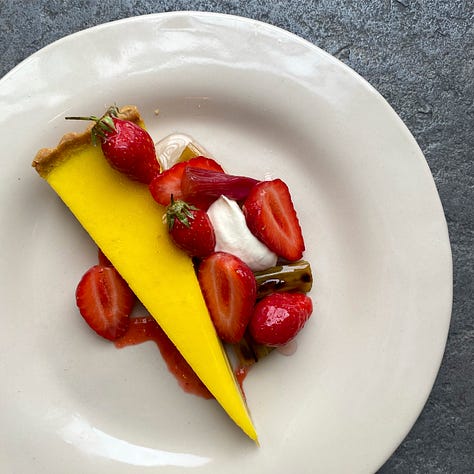
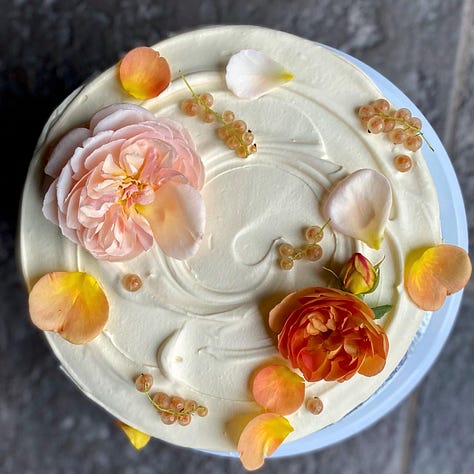
Much of Sarah's approach relies on this principle - she avoids cold storage and its dulling effect where possible, never letting freshly squeezed juice sit for too long before using it. The clementine sorbet recipe in Fruitful, for example, explains in the headnote how she used to squeeze the fruit at 11am to churn it ready for service at noon, fully preserving the vibrancy of the fruit. This makes me realise that fruit's big weakness, its fleeting nature, is also its greatest strength.
Another critical tenet of Sarah's approach to dessert is her commitment to keeping flavours both "clean and clear". She explains that often in cooking, "Every component needs to be treated differently." This means that in a dish with almonds, strawberry and rhubarb, you might join together a slice of cake with "pure almond flavour" with strawberries, which are "kept fresh and macerated" and rhubarb "that's roasted to exactly the temperature that rhubarb needs to be roasted."
This way, Sarah explains, you "can taste the rhubarb, you can taste the strawberry, you can taste the almond and you can taste it all together. That's what a lot of my dishes are built on." You can see it in action throughout Fruitful, as well as in today’s KP+ recipe for Frozen-Yoghurt Parfait and Flash Roasted Blueberries, and the passionfruit genoise with mango recipe she wrote for this newsletter last month.
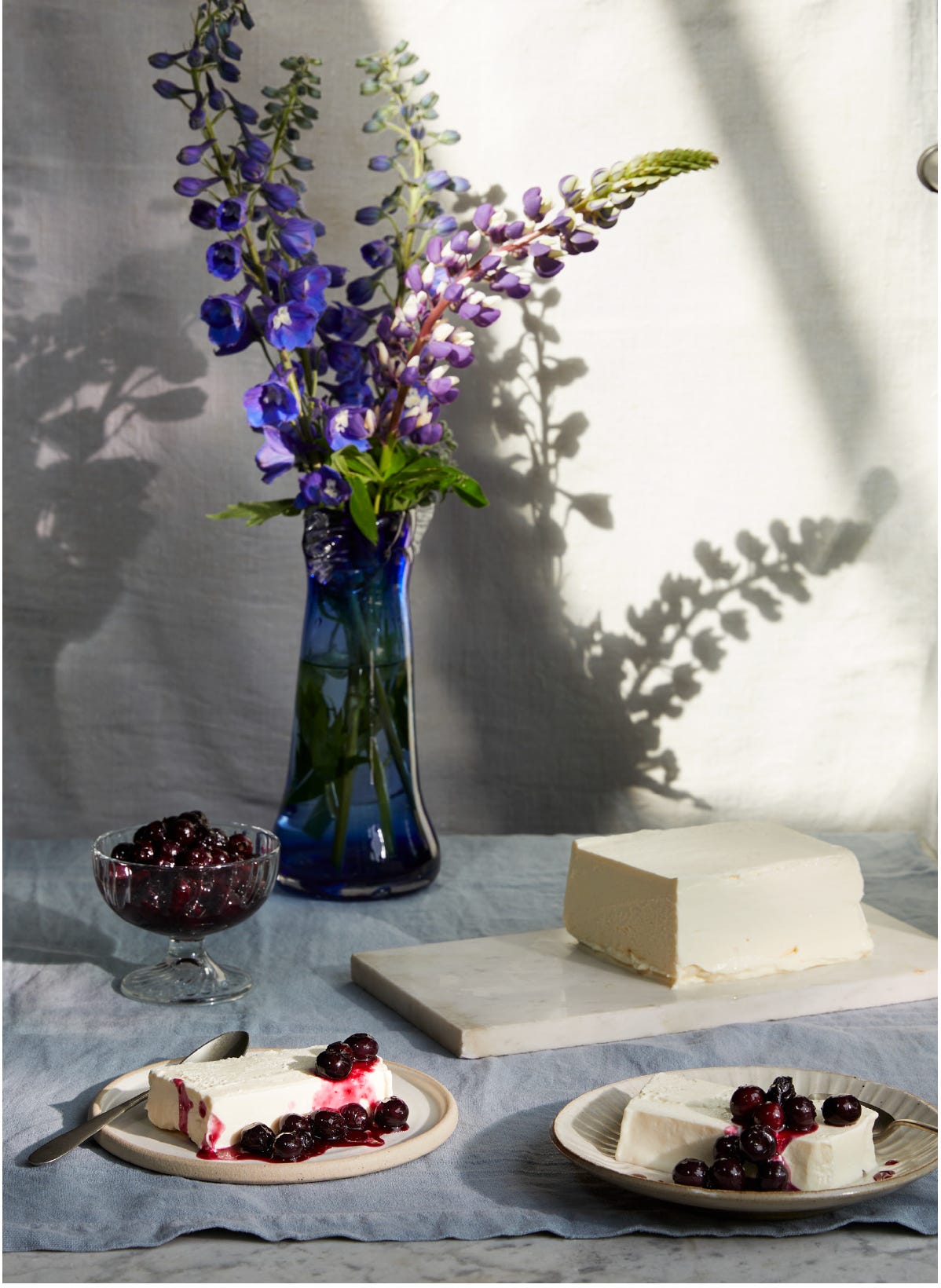
On Developing Recipes
Speak to any recipe developer, and they'll tell you horror stories of submitting out-of-season recipes for long lead publications (when the ingredients will be in season.) Mine involves begging rock-hard peaches to comply, while Sarah's involves her hard-won Quince recipes in Fruitful. "All I could find were bruised quinces."
Like many cookbooks, Fruitful started as something a little different. "The original book I wrote was a sweet book with a coconut, mango and melon section. Those got cut as I brought in more savoury recipes."
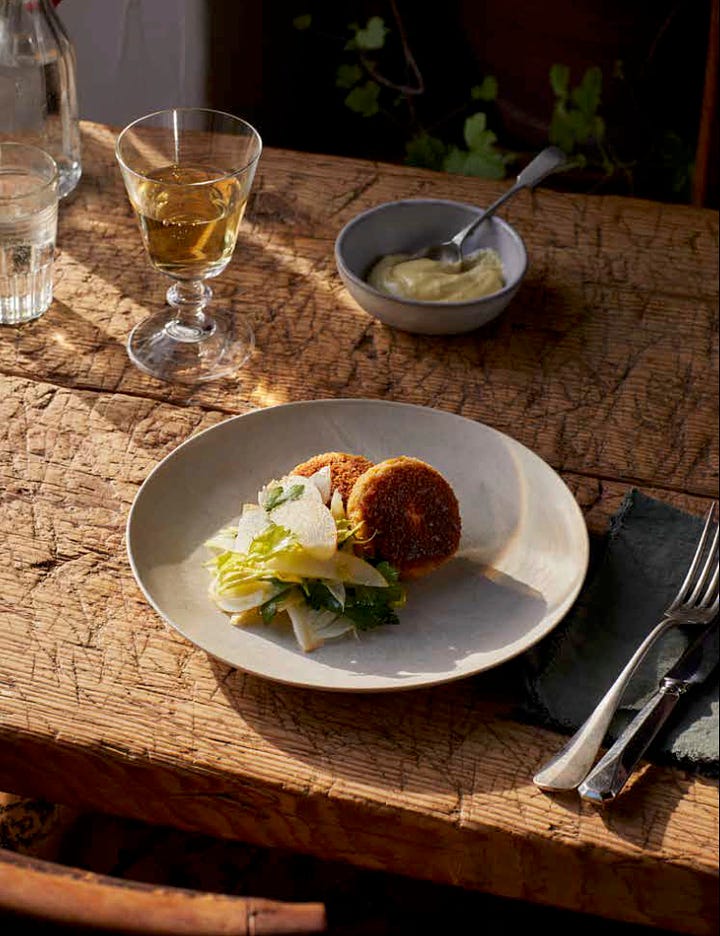

A pastry chef writing savoury recipes, you ask? Well, you are in good hands (and, though I am not tooting my own specific personal horn, I've never met a pastry chef who isn't also a good savoury cook!). Though Sarah's professional career has always been in the pastry kitchen, her early days in the Front of House team at Chez Panisse drive her flavour pairings, sweet and savoury alike. "When I was a server we would taste the food every shift, but you would also taste the wine on the menu and you get really good at knowing how to pair different flavours. And what is wine if not a fruit, you know?"
With these skills, she matches fennel, almond, and greengages in a cake as confidently as she matches blackcurrant, black pepper, and duck. Other pairings include plum and lamb ("The tannins in the skins of plum hold up to the strong, more pastoral flavour of the lamb") and slow-cooked salmon and pickled rhubarb relish.
At the heart of the book
Though its form changed, the guiding inspiration never faltered. "I kept coming back to this image of me as an intern at Chez Panisse in this tiny little room with boxes stacked up above my head and just smelling like all the fruits. I can still smell the page mandarins, the frog hollow peaches…" recalling the names of every single variety of fruit she tried.
You might be surprised to hear this, but plenty of pastry chefs and kitchens barely interact with fresh fruit. For consistency, efficiency and - usually - to save money, many fruit dishes in fancy patisseries begin as a frozen block of puree. Counter to her own experience, Sarah realised some chefs had never worked with fresh fruit despite coming from cooking school and other well-known kitchens.
"[Fruit] is what I really first fell in love with. And so," she explains, "If there was any story I was going to tell, it was going to be that one, or if there was any book I was going to write, it had to be that one."
Fruitful: Sweet and Savoury Fruit Recipes Inspired by Farms, Orchards and Gardens by Sarah Johnson is published by Kyle Books. Photography by Patricia Niven. Click here to get a copy.
Food Styling by Dor Harel and Henrietta Clancy. Location and Styling Direction by Lisa Gulick. Prop Styling by Rachel Vere. Farm Location is Heckfield Home Farm and Produce and Flowers are from Fern Verrow Farm.
The Recipe: Cherry Schiacciata
Extracted from Fruitful: Sweet and Savoury Fruit Recipes Inspired by Farms, Orchards and Gardens by Sarah Johnson published by Kyle Books. Out now.
Baking bread often demands a time commitment that many of us struggle to accommodate within a single day. That's why I adore this recipe— I can mix it together in under 30 minutes the first day, then let it prove overnight and bake it the following day.
Serves 6-8
Ingredients
330g (11½oz) bread flour
220mlk (8 fl/oz) warm water
5g (1/8oz) mild honey
5g (1/8oz) active yeast
7g (¼ z) salt
4 teaspoons of olive oil, plus extra as needed
450g (1lb) cherries, pitted
1 teaspoon of fennel seeds (optional)
flaky salt, to finish (I like Maldon or fleur de sel)
Method
Combine the flour, warm water, honey and yeast in a bowl and mix everything together for 2 minutes. Cover loosely with a tea towel and rest in a warm place for 15 minutes. Add the salt and olive oil and continue to mix for another 2 minutes. Meanwhile, coat a large bowl with oil, then add the dough and cover with a towel. Place into the fridge overnight.
The following day, place a baking stone or inverted baking tray on the middle shelf of the oven. Take another baking tray and brush the bottom generously with olive oil. Remove the dough from the fridge and carefully turn the dough on to the tray. Drizzle the top with more oil, then use the tips of your fingers to gently stretch the dough to 40cm (16in) long. Cover lightly with a tea towel and leave to prove in a warm place for 30 minutes –1 hour.
Preheat the oven to 190°C / 375°F / gas mark 5.
While the bread is proving, prepare the cherries. Use a cherry pitter to remove the stones. Alternatively, slice the cherries in half, pull out the stones and place the cherries into a bowl. Dot the cherries over the dough and scatter the fennel seeds evenly over the dough, if you like. Bake for 20–30 minutes or until golden. Remove the schiacciata from the oven and drizzle with more olive oil and sprinkle with large flakes of salt. Serve warm or room temperature. This is best the day it is made, but any leftovers make a nice morning snack.
Variation: Replace the pitted cherries with grapes and swap the fennel seeds for rosemary.





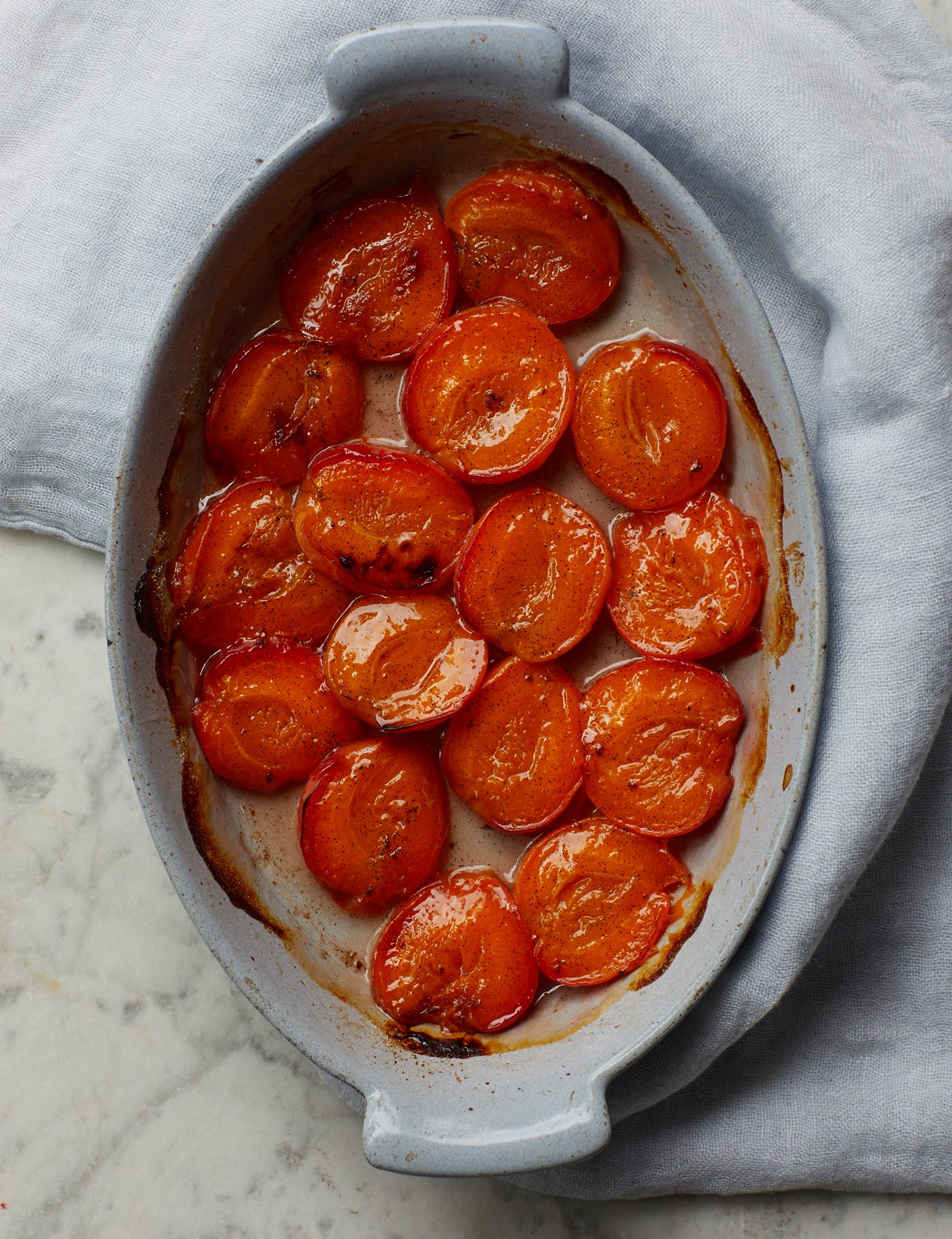
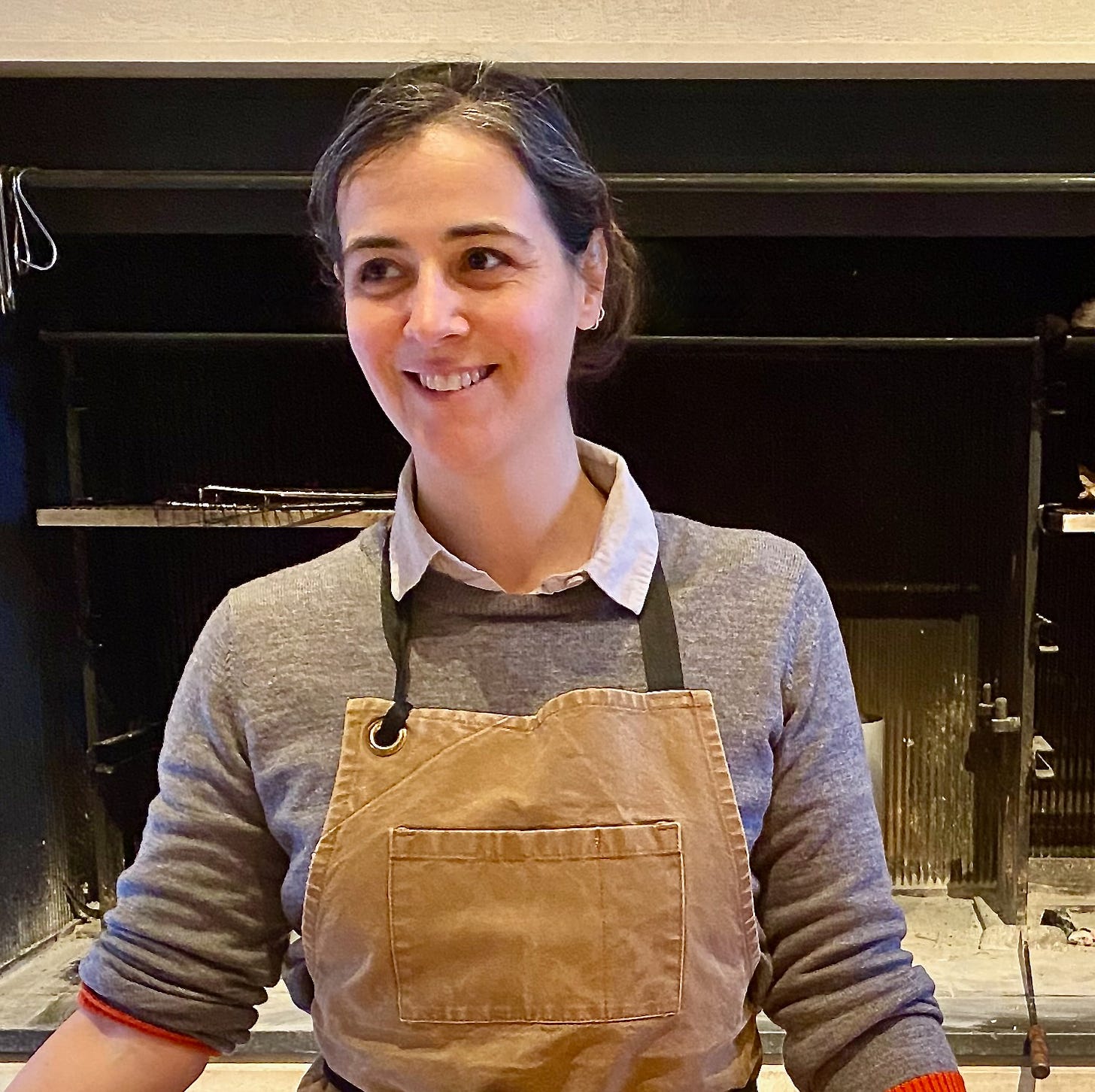

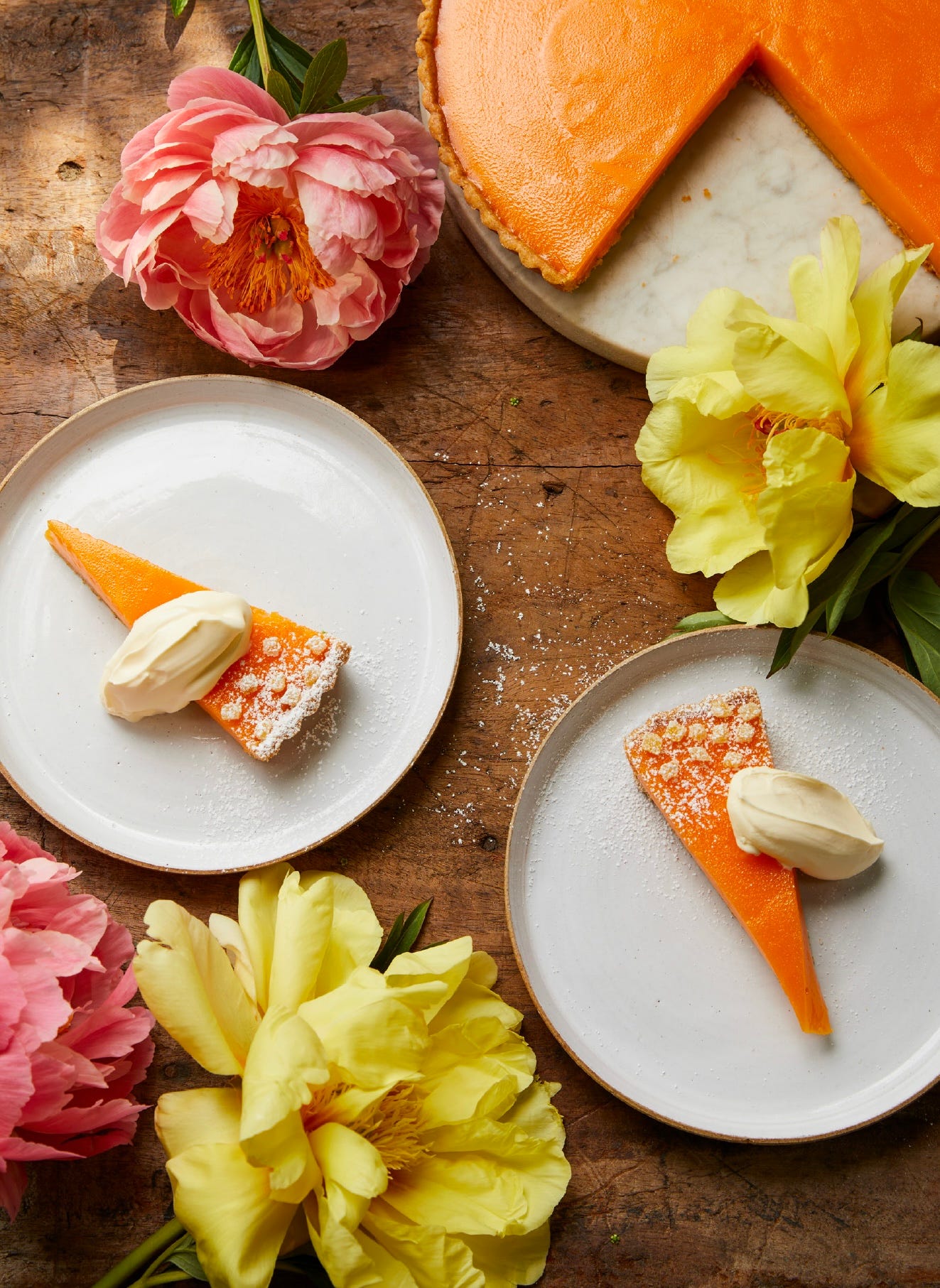


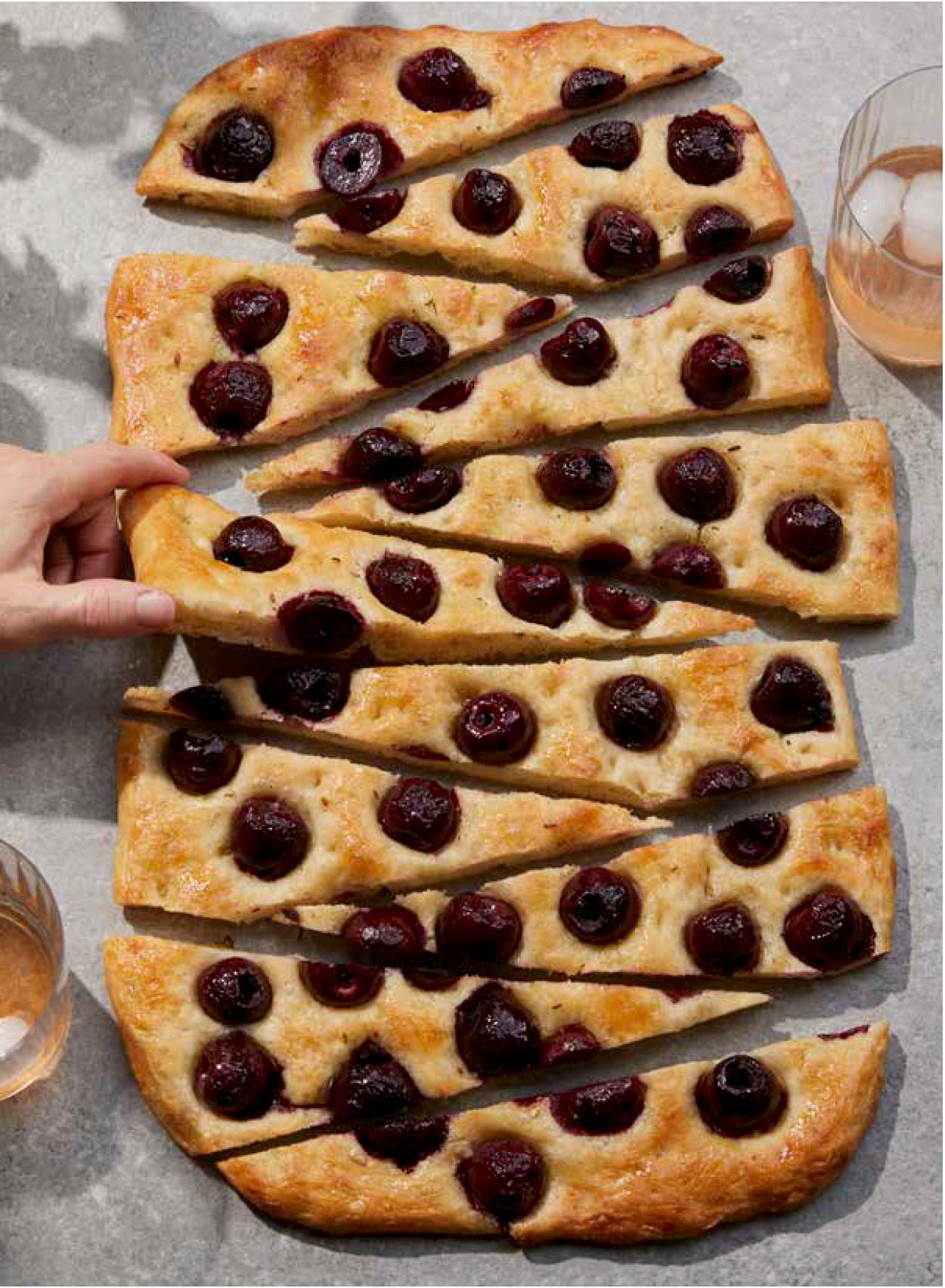
She’s so right about peaches. That is a fruit I miss. It’s just not the same in the U.K.
This interview helps me to appreciate fruit and the access we have to its many varieties almost year round. Loved hearing how the author is knowledgeable about fruit and how she creates dishes that allow any fruit to shine and taste their best. One can tell she loves what she does!